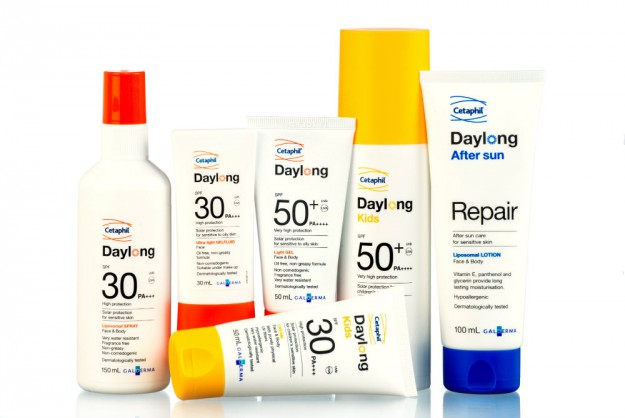Daylong: 10 Burning questions about sun protection answered
mis à jour le 12 August 2015 à 00:00From picking the right sunscreen to common application mistakes, we spoke to Eunice Chan, Product Manager of Daylong Singapore for her expert notes on sun protection.
Being in a country with perpetual sunshine can be great and not so great at the same time. Sure we get to head out of the house without so much as worrying about bringing a coat or layering to stay warm but on the flip side, the fear of the dreaded sun becomes a very real thing.
Slathering on sunscreen is the obvious way to protect yourself from the sun's rays but how certain are you that you're getting the adequate protection? So from understanding what factors to consider when purchasing sunscreen, to everything under the sun about SPF and common mistakes with application, we spoke to Eunice Chan, Product Manager of Daylong Singapore to learn more about this confusing but crucial product in our beauty cabinet.
Marie France Asia: What are some of the long term concerns of using sunscreen especially those with higher SPF?
Eunice Chan: As with all other cosmetic products, the long term effects of sunscreen are not known. However, cosmetics & sunscreen products from reputable companies like Daylong are formulated to comply with regulations & recommendations by scientific/legislative bodies. These scientific/legislative bodies collectively assess and decide which ingredients and concentrations are acceptable in the different types of products intended for human use. Therefore, the risk of potential long term effects is managed to be as low as possible.
MFA: Are there any issues that can arise from using multiple products with SPF?
E.C.: Applying multiple products with SPF does not offer higher protection. It is important to note that the total amount of protection at any time is only equivalent to the highest SPF product applied in sufficient quantity.
Daylong SPF 30 Face Gel-fluid is good for pre make up application, as it is easy to spread, has a fast absorption and gives a non-sticky, matt finish.
MFA: Would a spray-on sunscreen be as effective as a lotion?
E.C.: As long as the amount of sunscreen sprayed on is sufficient to fully coat the exposed skin, a spray on sunscreen would be just as effective as a lotion.
A spray on sunscreen such as Daylong SPF 30 Face & Body Spray Lotion is specifically suited for body parts that are hard to reach, and provides convenience to users without compromising the effectiveness of sunscreen, giving high protection against UVB, UVA & IR with SPF 30/ PA+++.
For kids above 12 months old with sensitive skin or atopic dermatitis, Daylong Kids SPF 50+ Face & Body Lotion is convenient for parents to apply on their children, and gives very high protection against UVB, UVA & IR with SPF 50+/PA++++, while nourishing delicate skin with glycerin, dexpanthenol, and Vitamin E.
MFA: What kind of damage can Infrared Radiation do as compared to UVA or UVB?
E.C.: Infrared (IR) radiation has longer wavelengths than Ultraviolet rays (UVB, UVA) and is accountable for around 50% of the solar radiation. It is the only radiation that penetrates deeper into skin layers beyond the dermis to the subcutis. IR radiation penetrating the skin is capable of reducing collagen and elastic synthesis and accelerating skin aging.
MFA: Buying sunscreen is typically very confusing, what are some factors to look out for?
E.C.: Choose a broad-spectrum sunscreen like Daylong that can protect against UVA, UVB and IR rays. Ideally, a sunscreen should have a UVB protection of SPF30 and above and a UVA protection of PA+++.
MFA: What is the biggest mistake people tend to make when applying sunscreen?
E.C.: Not applying adequate sunscreen! The official recommendation is to apply 2mg/cm2, which is equivalent to ½ or 1 teaspoon of sunscreen for the face or 30ml per application for an average adult body.
MFA: Are we potentially reducing the amount of Vitamin D exposure by using sunscreen?
E.C.: Based on WHO recommendation, just 5 to 15 minutes of casual sun exposure to hands, face and arms, 2 – 3 times a week during summer months, will provide sufficient vitamin D for most people. As Singapore is close to the equator where UV levels are much higher, it is unlikely for most people to become deficient in vitamin D from the use of sunscreen. Besides, Vitamin D can also be found in fortified foods such as flour, cereals, milk, cheese, eggs, and animal liver. The risk of UV damage to skin is a more pertinent concern than getting insufficient Vitamin D.
MFA: When going for a swim, how does one protect themselves from the sun if sunscreens are not water resistant?
E.C.: All Daylong sunscreens are very water resistant. However, it is still recommended to apply several times in order to maintain sun protection, especially after swimming, drying off and sweating, or after every 2-3 hours of water activity in the sun.
In case of sun damage due to insufficient reapplication, Daylong After Sun Repair is useful to aid in the repairing and regeneration of sun-exposed skin. It contains ingredients to actively support the skin’s own repair mechanism and moisturises skin with glycerin, panthenol and Vitamin E.
MFA: Are oral sunscreens a good idea?
E.C.: Oral sunscreens offer additional protection to the skin on top of applied sunscreen and are not meant to be a substitute for leave-on sunscreens.
MFA: Is lighter skin more prone to skin cancer?
E.C.: Lighter skin has lower levels of melanin and is more prone to UV damage. Generally speaking, people with lighter skin are relatively more at risk of skin cancer than people with darker skin. However, it is also important to note that there are other factors contributing to risk of skin cancer other than skin tone, e.g. exposure to UV/carcinogenic substances, genetics. Hence, an individual’s risk of skin cancer cannot be determined based on skin tone alone.
Tarandip Kaur




